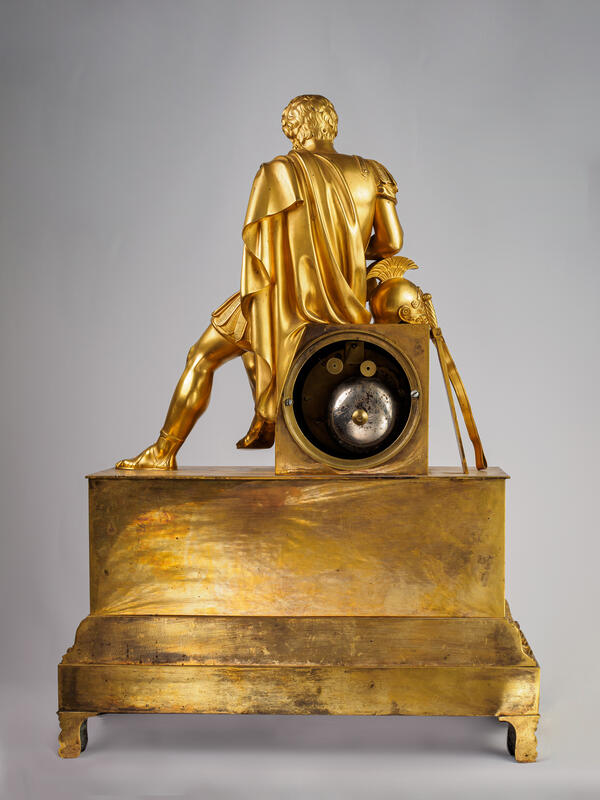The collection of the Uglich Museum features an old Empire-style mantel clock made in the 19th century.
Mantel clocks, as we know them, appeared only in the 15th century. It was then that a prototype of a modern clock with a fixed face and moving hands was developed. As the exterior of the clocks was continuously evolving, its working mechanism was being modified as well and gradually becoming more sophisticated. The first weight-driven clocks appeared in Italy, and by the 16th century, Nuremberg and Augsburg had become centers of clockmaking.
The next century was marked by the introduction of a pendulum. It was invented by the Dutch master Christiaan Huygens in the 1660s and made a breakthrough in the development of clockmaking. The English craftsmen adopted the Dutchman’s ideas, and by 1680 the best clocks were made in London. Among the most famous clockmakers of the time were East, Fromanteel, Graham, Knibb, Quare, and Tompion. The clock mechanisms made by them were exported to Europe, Turkey, and China.
The 19th century was the time of fast development of factory clock- and watchmaking — the transition from artisan labor in workshops to mechanized labor in factories and the appearance of mass-produced clocks and watches. The leaders of the process, which began at the end of the 18th century, were Switzerland and France.
In the second half of the 19th century, the situation changed. The leadership in the mass production of clocks and watches was overtaken by Germany and the USA. Accordingly, the export of watches from those countries was also increasing. Meanwhile, Switzerland sought to retain its positions due to a large number of small clock- and watchmaking companies.
The clockmaking companies P. Buhre, H. Moser, and W. Gabus were well-known in Russia and had their main production facilities in Le Locle, Switzerland. In some Russian cities, they kept chains of shops, warehouses, and workshops, where they assembled ready-made clocks and watches from imported parts. The cases for fireplace and table clocks were made on site by Russian craftsmen. The practice was determined by the fact that the duty on finished clocks and watches was much higher than on parts that were considered raw metal. The range of products was quite diverse. P. Buhre and H. Moser imported mechanisms for pocket watches, table, carriage and mantel clocks, W. Gabus — mechanisms for pocket watches and wall-mounted clocks.
Subsequently, the firms of P. Buhre and H. Moser received the status of Suppliers of His Imperial Majesty’s Court, which enabled them not only to establish themselves in Russia but also to expand the production in their native Switzerland.
Mantel clocks, as we know them, appeared only in the 15th century. It was then that a prototype of a modern clock with a fixed face and moving hands was developed. As the exterior of the clocks was continuously evolving, its working mechanism was being modified as well and gradually becoming more sophisticated. The first weight-driven clocks appeared in Italy, and by the 16th century, Nuremberg and Augsburg had become centers of clockmaking.
The next century was marked by the introduction of a pendulum. It was invented by the Dutch master Christiaan Huygens in the 1660s and made a breakthrough in the development of clockmaking. The English craftsmen adopted the Dutchman’s ideas, and by 1680 the best clocks were made in London. Among the most famous clockmakers of the time were East, Fromanteel, Graham, Knibb, Quare, and Tompion. The clock mechanisms made by them were exported to Europe, Turkey, and China.
The 19th century was the time of fast development of factory clock- and watchmaking — the transition from artisan labor in workshops to mechanized labor in factories and the appearance of mass-produced clocks and watches. The leaders of the process, which began at the end of the 18th century, were Switzerland and France.
In the second half of the 19th century, the situation changed. The leadership in the mass production of clocks and watches was overtaken by Germany and the USA. Accordingly, the export of watches from those countries was also increasing. Meanwhile, Switzerland sought to retain its positions due to a large number of small clock- and watchmaking companies.
The clockmaking companies P. Buhre, H. Moser, and W. Gabus were well-known in Russia and had their main production facilities in Le Locle, Switzerland. In some Russian cities, they kept chains of shops, warehouses, and workshops, where they assembled ready-made clocks and watches from imported parts. The cases for fireplace and table clocks were made on site by Russian craftsmen. The practice was determined by the fact that the duty on finished clocks and watches was much higher than on parts that were considered raw metal. The range of products was quite diverse. P. Buhre and H. Moser imported mechanisms for pocket watches, table, carriage and mantel clocks, W. Gabus — mechanisms for pocket watches and wall-mounted clocks.
Subsequently, the firms of P. Buhre and H. Moser received the status of Suppliers of His Imperial Majesty’s Court, which enabled them not only to establish themselves in Russia but also to expand the production in their native Switzerland.





